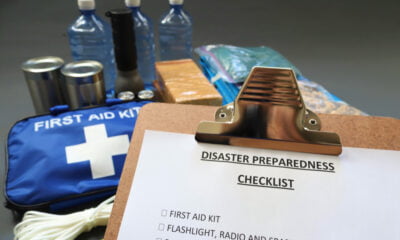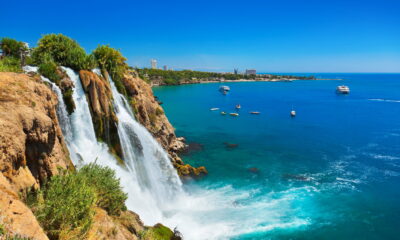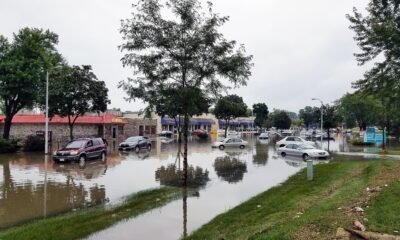

Environment
S&P: Climatic Perils Are Likely To Intensify, Hitting Poorer Sovereigns Harder, Says S&P Report
Standard & Poor’s Ratings Services for the first time has simulated the hypothetical ratings effect of natural disasters, and found that rare but calamitous events can have a measurable credit impact, in a report titled,”Storm Alert: Natural Disasters Can Damage Sovereign Creditworthiness.”
“Our simulations indicate the impact that rare but severe natural disasters–those that can be expected once every 250 years–can bring to bear on sovereign ratings. The biggest ratings impact is likely to come from earthquakes, followed by tropical storms,” Mr. Kraemer said. “Geographically, ratings of sovereigns in Latin America and the Caribbean appear to be most at risk, followed by Asia, taking into account higher geologic and climatic hazards than in the rest of the world.”
“The ratings of low-income developing sovereigns are particularly vulnerable to severe natural catastrophes,” Mr. Kraemer added, “followed by emerging and the less threatened advanced economies. It is therefore no coincidence that sovereigns with lower ratings tend to be more vulnerable to natural catastrophes than higher-rated sovereigns.”
In Japan for example, a 1-in-250-year event could cause a significant economic downturn and a decline in the sovereign rating by at least two notches (see table below), with potentially severe economic and financial repercussions for the rest of the world. We believe that in the immediate aftermath, the earthquake would result in a disruption of trade flows, block supply channels, with a simultaneous sell-off of foreign assets held by the Japanese residents and partial repatriation of Japanese financial assets held abroad, possibly causing an economic slowdown in the rest of the world and turmoil in global financial markets.
To quantify hypothetical ratings impact, Standard & Poor’s used direct damage data provided by Swiss Re in constructing a simplified sovereign rating tool. We simulated the impact over a five-year period of a one-in-250-year
occurrence of four perils (earthquakes, tropical storms, winter storms, and floods) on key macroeconomic variables: GDP growth, the balance of payments, as well as on general government debt and deficits.
We see particularly large potential direct economic damage and related pressure on creditworthiness for sovereigns on or close to the edges of Earth’s geological plates, for example, around the Pacific Rim (for example Chile, Costa Rica, Ecuador, Japan, Panama, Peru, Philippines, Taiwan), in the Caribbean (Costa Rica, Dominican Republic, Panama), and on the North Anatolian fault (Turkey).
TOP-10 RATING IMPACT OF SIMULATED 1-IN-250-YEAR NATURAL DISASTERS
Sovereign – Peril – Potential downgrade (notches)
Dominican Rep. – Tropical storm and surge -2.5
Chile – Earthquake – 2.4
Bangladesh – Tropical storm and surge – 2.2
Japan – Earthquake – 2.1
Costa Rica – Earthquake – 1.8
Vietnam – Tropical storm and surge – 1.8
Peru – Earthquake – 1.8
Thailand – Flood – 1.6
Taiwan – Earthquake – 1.3
Turkey – Earthquake – 1.3
There are wide differences among the sovereigns concerned (see table). For example, for the most affected sovereigns listed above, the hypothetical ratings would decline by at least one notch for some (for example, for Costa
Rica, Ecuador, Panama, Peru, Philippines, Taiwan, and Turkey) and almost two or potentially more for others (Chile and Japan). In many other sovereigns, the ratings impact is at least half a notch, indicating material downward pressure (Colombia, Dominican Republic, Indonesia, Israel, Italy, Mexico, and New Zealand).
S&P believe that one way to mitigate the economic and ratings implications of natural disasters is catastrophe insurance. In the case of the five biggest earthquakes covered in the study, the rating impact would be a downgrade of about one notch if 50% of the damage were reinsured, compared with almost two notches for no insurance coverage at all. We believe that these findings are particularly relevant for emerging and developing sovereigns. They are typically the most vulnerable to natural disasters in terms of direct and indirect economic losses and, as a result, creditworthiness. It is also in those economies where insurance coverage is typically low.
For other perils, sovereign ratings in our sample would come under pressure if a one-in-250-year tropical storm hits, although generally less than in the case of an earthquake scenario.
For floods, the economic impact on the most advanced developed sovereigns in Europe, while not negligible, appears to be limited and unlikely to lead to sovereign rating downgrades. Among the sovereigns covered in this report,
severe floods would cause the most economic damage in Hungary and Thailand, weakening their macroeconomic metrics and creditworthiness.
Sovereigns in Europe are frequently hit by winter storms, but given the relatively low direct damage as a percentage of value and high insurance coverage, macroeconomic consequences of winter storms do not appear to be
significant. Winter storms are unlikely to lead to downward pressure on sovereign creditworthiness.
“Looking ahead, climatic perils could intensify in line with past trends as climate change gathers pace. Specifically we view it as possible that storms and floods will become more frequent and more severe as the average global temperature rises and weather patterns shift,” Mr. Kraemer said.
“Before long, this could lead to an upward revision of the damage caused by one-in-250-year catastrophes, and thereby also result in a stronger hit to ratings than suggested in this report,” he added. “We expect that climate
change-induced intensification of the frequency and severity of natural disasters would hurt the ratings on poorer sovereigns the most, adding to global ratings inequality.”


 Environment10 months ago
Environment10 months agoAre Polymer Banknotes: an Eco-Friendly Trend or a Groundswell?

 Environment11 months ago
Environment11 months agoEco-Friendly Home Improvements: Top 7 Upgrades for 2025

 Features9 months ago
Features9 months agoEco-Friendly Cryptocurrencies: Sustainable Investment Choices

 Features10 months ago
Features10 months agoEco-Friendly Crypto Traders Must Find the Right Exchange






























